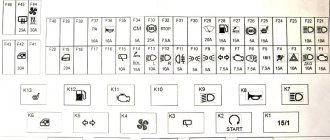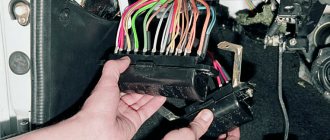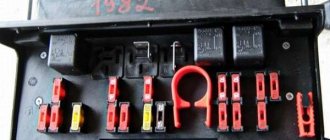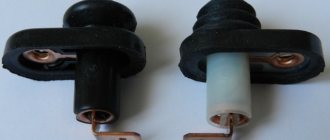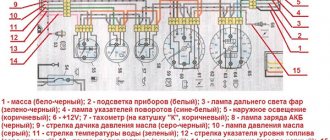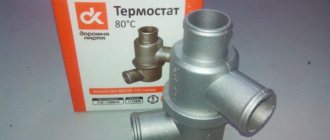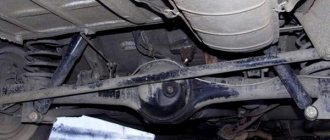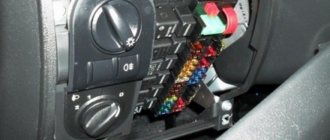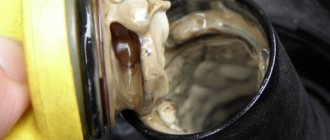The electrical circuits of VAZ 2106 consumers are protected by fuses located in a special block. Low reliability of fuse links leads to periodic malfunctions and malfunctions of electrical appliances. Therefore, sometimes it is necessary to change both the fuses and the unit itself to a more reliable one. Repair and maintenance of the device can be carried out by every owner of a Zhiguli without visiting a car service center.
- Fuse box problems and troubleshooting
How to identify a blown fuseVisual inspection
- Diagnostics with a control and a multimeter
- Video: checking fuses without removing them from the car
- Table: VAZ 2106 fuse ratings and circuits they protect
- Video: replacing the fuse box of a classic Zhiguli car with a Euro block
VAZ 2106 fuses
Every car is equipped with various electrical appliances. The power circuit of each of them is protected by a special element - a fuse. Structurally, the part is made of a body and a fusible element. If the current passing through the fuse-link exceeds the calculated rating, it is destroyed. This breaks the electrical circuit and prevents overheating of the electrical wiring and spontaneous combustion of the car.
From the factory, cylindrical fusible links are installed in the VAZ 2106 fuse box
Fuses on the VAZ 2106: which one is responsible for what
One of the most common types of repairs in the electrical equipment of VAZ 2106 cars is a malfunction in the fuse circuits, which quite often lose contact with the conductive plates.
In general, the design of standard fuses is not particularly conducive to reliable contact; as soon as more resistance appears than usual, the fuse begins to heat up, then the contact becomes even worse, and so on until contact is lost.
The same thing happens when the pressure on the plates that hold the fuse is released. There is also a danger here - if there is poor contact on the fuse itself, it may not work in the event of a short circuit, but will only begin to heat up quite seriously, as a result of which the fuse itself may cause a fire.
But more often the following situation is observed: due to poor contact, the fuse begins to heat up quite strongly; if it is made of plastic, then the plastic insert melts and the fuse becomes “short”, falls out of its socket, while the conductive path remains intact. The situation is slightly different with fuses in which plastic is replaced with a ceramic insert - they can heat up even more, which further damages the sockets.
Maintenance and repair. VAZ 2106 fuses
— Cleanliness of landing nests. I think everything is clear here, the cleaner the fuse socket, the less resistance in this circuit and, as a result, less heating. If the contacts are dirty, the fuse heats up and melts, a short-term loss of contact is possible, which is quite dangerous, for example in the case of light
— Compliance of fuse ratings with manufacturer’s recommendations. It is also quite important not only to keep the contact groups clean, but also to use fuses of the ratings recommended by the manufacturer. Ignoring these requirements threatens the failure of electrical equipment in the network or, even worse, a fire.
- Do not under any circumstances replace a fuse in a VAZ 2106 or in another car with a so-called “bug”, coin, screw or other thing. I think you yourself understand that the fire is not far from here.
— The fuse has tripped. This is a fairly common situation and there is no need for hasty decisions; first you need to find out which circuit this fuse protects (below is a list of protected circuits and fuse numbers for the VAZ 2106, I hope there will be one for other models soon). Then try to remember, understand what could have caused the short circuit; it is highly not recommended to insert a new fuse in place of the blown fuse if the cause of the blown fuse has not been eliminated. If you find the cause, then eliminate it, insulate the wires, insert a new fuse.
— The fuses are melting. If the conductive section melts, then this is understandable, most likely a short circuit. But if a plastic insert melts, then this is a signal of poor contact in the socket or an overload of the circuit protected by this fusible insert.
— Additional consumers have their own fuse! You should not connect many third-party consumers (radio, heating, etc.) to one fuse!
Protected circuits and fuse numbers in the VAZ 2106
The headlight, heater fan, interior light and similar faults do not work, it is worth starting to repair them by checking the reliability of the contact on the fuse protecting this circuit.
So, let's start, the photo below shows a standard VAZ 2106 fuse box, numbering, as you can see, starts on the left side, from the driver's door. In VAZ 2106 older years of production, as well as in VAZ 2103, VAZ 2101, there is no additional fuse block. It is available in new models that have additional consumers - heated glass, electric cooling fan, etc.
1. Fuse No. 1 protects the circuits of the horn, clock, brake lights, cigarette lighter, and front door open alarm lights. Fuse rating is 16A.
2. Fuse No. 2 protects the circuits of the windshield washer, windshield wipers, and heater motor. Fuse rating is 8A.
3. Fuse No. 3 for the left high beam headlights, as well as the high beam indicator lamp in the speedometer (blue). Fuse rating is 8A.
4. Fuse No. 4 protects the right high beam headlights. Fuse rating is 8A.
5. Fuse No. 5 protects the left low beam headlights from short circuits. Nominal 8A.
6. Fuse No. 6 protects the circuit of the right low beam headlights. Nominal 8A.
7. No. 7 protects the trunk light circuit, instruments, license plate light, cigarette lighter, left front side light and right rear side light. Nominal 8A.
8. Fuse No. 8 protects the side light warning lamp circuit, the license plate light, the engine compartment light, the right front side light and the left rear side light. Nominal 8A.
9. Fuse No. 9 protects the tachometer circuit, the winding of the rear window heating relay, the reverse lamp, the glove box lighting, the battery charge indicator lamp, the parking brake activation, the brake fluid level, the carburetor choke control (on the website you can find an article about adjusting the carburetor 2108), indicators for oil pressure, coolant temperature and fuel level, rotation. Nominal 8A.
10. Fuse No. 10 protects the battery charging circuit, namely the generator excitation circuit and the relay regulator. Nominal 8A.
11. Fuses No. 11, 12, 13 in the basic configuration are in reserve and can be used for additional equipment. The denomination is selected depending on the consumer.
12. Fuse No. 14 protects the rear window heated element circuit, if installed. Nominal 16A.
13. The protection circuit of fuse No. 15 contains an electric engine cooling fan, if one is installed in the vehicle. Nominal 16A
14. Fuse No. 16 protects the turn signal and hazard warning light circuits. Nominal 8A.
Let us remind you that the previous article was about installing a central lock on a VAZ 2106 with your own hands.
Purpose of main unit fuses
The fuses are located on the main (upper) and additional (lower) ones:
- F1, designed for a maximum current of 16 A, is necessary to protect the power circuits of the cigarette lighter, sound signal, interior lamps, clocks, brake lights, and light warnings about open doors.
- F2, response current 8 A, allows you to protect the circuits of the windshield wiper and its relay, the electric washer motor and the heater.
- F3, 8 Amperes, protects the power supply circuit of the left high beam headlight and the light control lamp.
- F4, current 8 A, right headlight (high beam).
- F5, F6, 8 Amperes – left and right headlights (low beam), respectively.
- F7 – side lights (right rear and left front), light in the luggage compartment, license plate illumination, instrument cluster, cigarette lighter. Rated current 8 A.
- F8 – side lights (left rear and right front), lamps under the hood and control panel on the dashboard.
- F9 – designed to protect the power circuits of oil pressure, fluid temperature, gasoline level, and reserve lamp indicators. It also supplies power to the warning lamp, which signals that the handbrake has been applied, as well as an emergency level of brake fluid, a lack of battery charge, and the closing of the air damper. The XX solenoid valve, tachometer, reverse lamps, glove compartment lights, rear window defroster relay are also powered from this fuse.
- Fuse F10 supplies power to the voltage regulator. Rating – 8 Amperes.
- F11, F12, F13 – reserve.
Additional fuse block
- F14 – fuse for protecting the power circuit of the rear window heater. Rated operating current 16 A.
- F15 – electric motor for cooling the radiator. Current 16 A.
- F16 – hazard warning lights and direction indicators.
When connecting a new unit, be sure to use the VAZ-2106 fuse diagram. This will prevent the elements from being mixed up.
Where is the low and high beam relay located on the VAZ 2106
Most of the relays, as well as the voltage regulator, are located in the engine compartment.
Location of the VAZ 2106 relay in the engine compartment
If it fails, it is recommended to replace the relay assembly, since if the winding is burned out, or the relay contacts are severely burnt, it is difficult to properly restore its functionality.
This is how the VAZ 2106 relays are located in the engine compartment: 1 – battery charge indicator relay;
2 – relay for turning on the high beam headlights; 3 – relay for turning on low beam headlights. The relay for turning on the high and low beam headlights and the relay for turning on the radiator fan of the engine cooling system are of the same type (90.3747-10 or 113.3747-10), are interchangeable and are replaced in the same way
Wiring diagram VAZ 2106 (injector)
1 controller 2 electric fan of the cooling system 3 ignition system harness connector to the left mudguard harness 4 ignition system harness connector to the right mudguard harness 5 fuel level indicator 6 fuel level harness connector to the fuel level sensor harness 7 oxygen sensor 8 fuel level sensor harness connector to the system harness ignition 9 electric fuel pump 10 speed sensor 11 idle speed control 12 throttle position sensor 13 coolant temperature sensor 14 mass air flow sensor 15 diagnostic block 16 crankshaft position sensor 17 canister purge solenoid valve 18 ignition coil 19 spark plugs 20 VAZ-2106 injectors 21 ignition system harness block to instrument panel harness 22 electric fan relay 23 controller power supply circuit fuse 24 ignition relay 25 ignition relay fuse 26 electric fuel pump power circuit fuse 27 electric fuel pump relay 28 ignition system harness block to injector harness 29 injector harness block to ignition system harness 30 block g guta instrument panel to the ignition system harness 31 ignition switch 32 instrument cluster 33 engine anti-toxic system display
Useful: Pinout of diagnostic connector for VAZ cars
